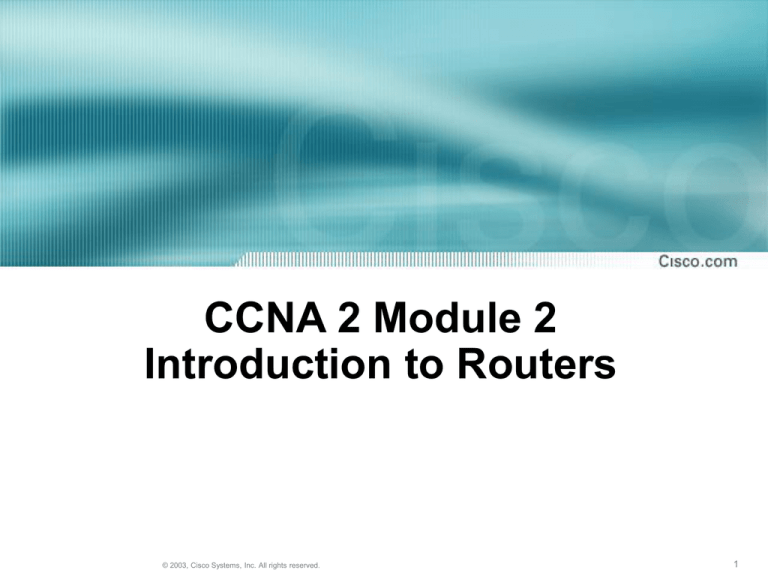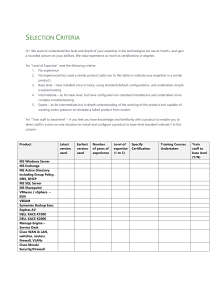
CCNA 2 Module 2
Introduction to Routers
© 2003, Cisco Systems, Inc. All rights reserved.
1
Objectives
• Upon completion of this module, the
student will be able to perform tasks
related to the following:
• Operating Cisco IOS Software
• Starting a router
© 2003, Cisco Systems, Inc. All rights reserved.
2
Purpose of Cisco IOS Software
• A router or switch cannot function without an operating
system.
• Cisco calls its operating system the Cisco Internetwork
Operating System or Cisco IOS.
• It is the embedded software architecture in all of the
Cisco routers and is also the operating system of the
Catalyst switches.
• The Cisco IOS provides the following network services:
• Basic routing and switching functions
• Reliable and secure access to networked resources
• Network scalability
© 2003, Cisco Systems, Inc. All rights reserved.
3
Router User Interface
• A user interface to a router or switch utilizes an ASCII terminal program. The
most commonly used version is the Windows HyperTerminal program.
• The Cisco IOS software uses a command-line interface (CLI)
• One way to access the CLI is through a console session.
• Another way to access a CLI session is by use of a dialup connection using
a modem or null modem connected to the router AUX port.
• Another method of accessing a CLI session is to Telnet to the router
© 2003, Cisco Systems, Inc. All rights reserved.
4
Router User Interface Modes
• The Cisco command-line interface (CLI) uses a hierarchical structure.
• This structure requires entry into different modes to accomplish particular
tasks.
• The IOS provides a command interpreter service known as the command
executive (EXEC).
• As a security feature the Cisco IOS software separates the EXEC sessions
into two access levels.
© 2003, Cisco Systems, Inc. All rights reserved.
5
Router User Interface Modes
Continued
© 2003, Cisco Systems, Inc. All rights reserved.
6
Cisco IOS Naming Conventions
© 2003, Cisco Systems, Inc. All rights reserved.
7
Operation of Cisco IOS Software
• The Cisco IOS devices have three distinct operating environments or
modes:
• ROM monitor
• Boot ROM
• Cisco IOS
• The configuration register setting can be used by the system administrator
to control the default start up mode for the router.
Note: To upgrade IOS image, have to verify if the memory is sufficient by
using “show flash” and “show version”
© 2003, Cisco Systems, Inc. All rights reserved.
8
The show version Command
• IOS version and
descriptive information
• Bootstrap ROM
version
• Boot ROM version
• Router up time
• Last restart method
• System image file and
location
• Router platform
• Configuration register
setting
© 2003, Cisco Systems, Inc. All rights reserved.
9
show flash Command
© 2003, Cisco Systems, Inc. All rights reserved.
10
Steps in Router Initialization
© 2003, Cisco Systems, Inc. All rights reserved.
11
Using the setup Command
© 2003, Cisco Systems, Inc. All rights reserved.
12
Router LED Indicators
Cisco routers use LED indicators to provide
status information. Depending on the Cisco
router model, the LED indicators vary.
© 2003, Cisco Systems, Inc. All rights reserved.
13
Examining Initial Bootup Output
tells the user that
this router has not
been configured yet
or that the NVRAM
has been erased
© 2003, Cisco Systems, Inc. All rights reserved.
14
Examining Initial Bootup Output
Continued
• Number of Interfaces
• Types of Interfaces
• Amount of NVRAM
• Amount of flash memory
© 2003, Cisco Systems, Inc. All rights reserved.
15
Examining Initial Bootup Output
Continued
© 2003, Cisco Systems, Inc. All rights reserved.
16
Establishing a Hyperterminal Session
• All Cisco routers include an
EIA/TIA-232 asynchronous
serial console port (RJ-45).
• Cables and adapters are
needed to connect a console
terminal (an ASCII terminal
or PC running terminal
emulation software) to the
console port.
© 2003, Cisco Systems, Inc. All rights reserved.
17
Router Modes
© 2003, Cisco Systems, Inc. All rights reserved.
18
Router Modes
Continued
• Global configuration mode commands are used in a router to apply
configuration statements that affect the system as a whole.
• When these specific modes are entered, the router prompt changes to indicate
the current configuration mode.
© 2003, Cisco Systems, Inc. All rights reserved.
19
User Mode Commands
--More-- indicates multiple
screens are available as output.
© 2003, Cisco Systems, Inc. All rights reserved.
20
Privileged Mode Commands
© 2003, Cisco Systems, Inc. All rights reserved.
21
clock set Command
© 2003, Cisco Systems, Inc. All rights reserved.
22
Using IOS Command history
• The command history is enabled by default and the system records 10
command lines in its history buffer.
• The maximum number of commands is 256.
© 2003, Cisco Systems, Inc. All rights reserved.
23
The User Interface Error Indicator
• The "^" (called caret) symbol appears at the point in the command string
where an incorrect command, keyword, or argument was entered.
© 2003, Cisco Systems, Inc. All rights reserved.
24
Summary
© 2003, Cisco Systems, Inc. All rights reserved.
25




